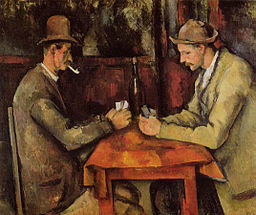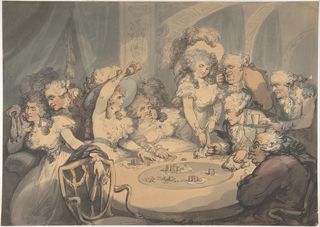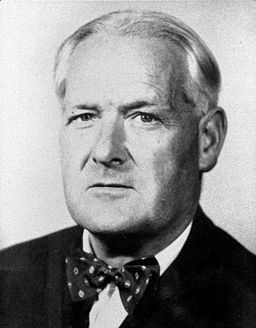Placebo
The Gambler's Fallacy in Research
Down the "statistical garden path" for those participating in clinical studies.
Posted June 18, 2017
“It is impossible to approach the gambling table without becoming infected with superstition,” writes Alexei Ivanovich, the Russian tutor in Dostoyevsky’s powerful novella The Gambler. Even Alexei’s “senseless and unseemly failure” earlier that day “has not left the slightest doubt” in him: he is still absolutely convinced that he will win.

The Gambler, set in the fictional German town of Roulettenburg, has the impact it does because Dostoyevsky was himself a compulsive gambler for many years who knew only too well the obsessive preoccupation and financial ruin that gambling can precipitate. Dostoyevsky’s theme has appeared in many subsequent artistic adaptations, including a Prokofiev opera of the same name that was directly inspired by the novella. The subject of gambling is a frequent one in paintings, such as by Bokelmann, Cézanne, Rowlandson, and Caravaggio, among others.
About the roulette wheel, Alexei explains, “…one morning, red will be followed by black and back again almost without any order, shifting every minute, so that it never turns up red or black for more than two or three strokes in succession. He continues, (p. 92) “Chance favors red, for instance, ten or even fifteen times in succession…Every one, of course, abandoned red at once, and …scarcely anyone dared to stake on it…” Alexei even tries to warn elderly and infirm Granny, who too has become thoroughly absorbed by the game, “… zero has only just turned up, so now it won’t turn up for a long time. You will lose a great deal; wait a little, anyway…” (p. 59)

Dostoyevsky’s Alexei demonstrates the two aspects of the so-called gambler’s fallacy: a statistical “misunderstanding” of the odds and unrealistic optimism that “supersedes statistical reasoning.” (Swekoski and Barnbaum, IRB: Ethics & Human Research, 2013) The gambler’s fallacy is “the belief that the odds for something with a fixed probability increase or decrease depending on recent occurrences,” i.e., “so if red comes up four times in a row, on the fifth time, it is more likely to be black.” (Wertheimer, Rethinking the Ethics of Clinical Research, 2011, note # 71, Chapter 3, p. 328) In other words, those who suffer from the gambler’s fallacy will not accept that each turn is independent of another and has the same 50% probability of recurring; he or she will instead believe that the probability of another red, for example, must be much lower after a succession of previous reds. The other aspect of the gambler’s fallacy, as evidenced in Alexei's words, is that “the odds are somehow suspended” and the odds of winning are “more certain.” Even the “statistically sophisticated” can believe, “Tonight is my lucky night.” (Swekoski and Barnbaum, 2013)

Though the gambler’s fallacy exists in many contexts, it may occur in those who participate in randomized controlled trials, the gold standard of clinical research, in which an experimental treatment of unknown efficacy is compared with either placebo (i.e., an inactive treatment for the condition) or more likely, in recent years, a different therapy. (Wertheimer, 2011; Swekoski and Barnbaum, 2013) Says Wertheimer, “Gambling is an interesting analogue to participating in research because it may involve considerable risks.” (p. 81) These investigators note that research subjects may likewise suffer from the same distorted reasoning and believe they, too, are “exempt from statistics” and have “undue optimism” about their chances of cure or treatment when they participate. (Swekoski and Barnbaum, 2013)
Subjects may volunteer for clinical research studies for different reasons, including a desire to help others, i.e., altruism; financial compensation given to participants; and variously other perceived personal benefits. (Detoc et al, Expert Review of Vaccines, 2017.) For example, participants may develop therapeutic appropriation (McDougall et al, Journal of Medical Ethics, 2016) whereby they may understand the research protocol but still want to join a study for individual therapeutic benefit, such as receiving additional tests and monitoring for their condition, increased access to hospital personnel or their own physician, and even other medical or social services. (McDougall et al, 2016) Henry Beecher, though, in his classic paper, (NEJM, 1966) has emphasized, “Ordinary patients will not knowingly risk their health or their life for the sake of ‘science.’”
Research subjects may also suffer from a related concept, what Appelbaum and colleagues have called therapeutic misconception (Appelbaum et al, International Journal of Law and Psychiatry, 1982; Lidz et al, Cambridge Quarterly of Healthcare Ethics, 2015): they may believe they are special and unique and will receive personal therapeutic benefit from a study, even though they may realize (and have been told) that the goal of research is different from that of clinical care. Therapeutic misconception involves the incorrect belief that a person’s individual needs will determine what treatment group (e.g., receiving medication rather than placebo) he or she will be assigned, rather than by unbiased random assignment. There are thus a misunderstanding and an unreasonable appraisal of both the process and goals of research.(Swekoski and Barnbaum, 2013)

Subjects who have a disease that is being investigated are "particularly vulnerable" to therapeutic misconception, and are often "desperate" to have access to an experimental treatment: they may "overestimate the benefits and underestimate the risks of research participation.” (Wertheimer, 2011, p. 33; Henderson et al, PLoS Medicine, 2007) They may not appreciate the “possibility that they will receive no therapy or (even) sub-optimal therapy.” (Charuvastra and Marder, Journal of Medical Ethics, 2008) Further, subjects may not even understand fully terms such as “double-blind,” “placebo,” or even “treatment” and “research.” (Henderson et al, 2007) And their expectations may derive "from both cultural images of the physician-patient relationship and their previous experiences with medical caregivers;” they may believe that physicians would suggest research only when their participation would be in their own "medical best interests.” In other words, they come to research with a “strong therapeutic bias” (Lidz and Appelbaum, Medical Care, 2002); unfortunately, though, “everything about a medical setting will evoke participants’ expectations of personal care.” (Lidz et al, 2015) Sometimes, therapeutic misconception “may be shared” by both subjects and researchers when researchers “may themselves believe they are acting in the best interests of the patient.” (Charuvastra and Marder, 2008)
What is the goal of research? It is achieving generalized knowledge for the potential benefit of society, rather than that of clinical care whose goal is to benefit the individual. (Breault and Miceli, Ochsner Journal, 2016) In clinical care, physicians have the “fundamental ethical obligation” to “prioritize the interests” of their patients. (Lidz et al, 2015) While research studies must protect patients from undue harm, i.e., the beneficence principle (Lidz and Appelbaum, 2002) they do not “prioritize” their patients’ interests above the study’s interests: randomization is impersonal. (Lidz et al, 2015) Their primary purpose is “to answer a research question..." (Breault and Miceli, 2016) A researcher’s frame is “independent of specific patient needs." (Lidz et al, 2015)

When researchers recruit their subjects for a study, they must convey to them five dimensions: (1) the scientific purpose is to produce generalizable knowledge and to answer questions about safety and efficacy; (2) study procedures are conducted for achieving scientific knowledge and not for their specific patient care; (3) there is inevitable uncertainty involved in both risks and benefits of the study; (4) there must be a strict adherence to the study’s protocol that may involve an inability to receive their current medications, etc.; (5) the clinician involved in the study is foremost an investigator, not a personal physician, whose task it is to assess safety and efficacy and not administer treatment. (Henderson et al, 2007; Breault and Miceli, 2016)
Patients, though, can compromise the well-meaning, but insensitive, intentions of clinicians, poignantly demonstrated in the film Dallas Buyers Club (2013), recipient of several Academy Awards. The film depicts the true story of Dallas electrician Ron Woodruff who contracted AIDS in the mid-1980s from unprotected heterosexual sex. It explores the desperation that Ron and his fellow sufferers experienced under the stringent controls of the FDA in the early days of the AIDS epidemic when clinical trials involved an inactive placebo control to assess the efficacy of AZT, the only potential medication then available in the U.S. Given a death sentence, Woodruff resorts to bribing a hospital staff member to ensure he receives active drug rather than placebo, and other study participants split their doses with those assigned to receive placebo. Ultimately, when his condition deteriorates, Ron resorts to smuggling in non-FDA approved medication from Mexico for himself and the other AIDS-ravaged patients in the hospital study, much to the exasperation of those physicians whose goal was to conduct unbiased research for generalized scientific knowledge.

Sometimes, though, patients may not necessarily be desperate, but just oppositional in their thwarting experimental protocol. British-born Sir Austin Bradford Hill (1897-1991), described as “a master of the methods by which arithmetic is made argumentative”(1) and considered by some to be the “greatest medical statistician” of the last century, was one of the first to appreciate the importance of designing and conducting randomized controlled trials on patients. (Doll, 1993, Statistics in Medicine). In his reminiscences, Hill describes the following as his personal favorite: “Doctor,” said the young woman, ‘Why have you changed my pills?’ The doctor replied, “What makes you think I have changed your pills?” “Well,” she replied, “last week, when I threw them down the loo, they floated, but this week they sank.” (Hill, British Medical Journal, 1985)

Bottom line: Research participants may have a vastly different understanding of the nature of research from those who design and conduct it. It behooves investigators to sort out what patients expect so they can avoid having their studies compromised by patients’ misconceptions, undue expectations, and failures to follow protocols.
Please note: My subtitle is a quote from Sir Austin Bradford Hill (NEJM, 1952)
(1) Doll’s description of Hill was borrowed from British politician Sir John Simon, who had used those words to describe another British statistician William Farr one hundred years earlier. (Doll, 1993).
For those interested in the many talents of Sir Austin Bradford Hill, see two of my previous posts, "Advise and Consent" and "Toward a 'Knowledge of Causes...and All Things Possible.'"




